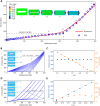3D stretchable and self-encapsulated multimaterial triboelectric fibers
- PMID: 36367937
- PMCID: PMC9651858
- DOI: 10.1126/sciadv.abo0869
3D stretchable and self-encapsulated multimaterial triboelectric fibers
Abstract
A robust power device for wearable technologies and soft electronics must feature good encapsulation, high deformability, and reliable electrical outputs. Despite substantial progress in materials and architectures for two-dimensional (2D) planar power configurations, fiber-based systems remain limited to relatively simple configurations and low performance due to challenges in processing methods. Here, we extend complex 2D triboelectric nanogenerator configurations to 3D fiber formats based on scalable thermal processing of water-resistant thermoplastic elastomers and composites. We perform mechanical analysis using finite element modeling to understand the fiber's deformation and the level of control and engineering on its mechanical behavior and thus to guide its dimensional designs for enhanced electrical performance. With microtexture patterned functional surfaces, the resulting fibers can reliably produce state-of-the-art electrical outputs from various mechanical deformations, even under harsh conditions. These mechanical and electrical attributes allow their integration with large and stretchable surfaces for electricity generation of hundreds of microamperes.
Figures





References
-
- Hashemi S. A., Ramakrishna S., Aberle A. G., Recent progress in flexible-wearable solar cells for self-powered electronic devices. Energ. Environ. Sci. 13, 685–743 (2020).
-
- Kim B. J., Kim D. H., Lee Y. Y., Shin H. W., Han G. S., Hong J. S., Mahmood K., Ahn T. K., Joo Y. C., Hong K. S., Park N. G., Lee S., Jung H. S., Highly efficient and bending durable perovskite solar cells: Toward a wearable power source. Energ. Environ. Sci. 8, 916–921 (2015).
-
- Pan S., Yang Z., Chen P., Deng J., Li H., Peng H., Wearable solar cells by stacking textile electrodes. Angew. Chem. 126, 6224–6228 (2014). - PubMed
-
- Allison L. K., Andrew T. L., A wearable all-fabric thermoelectric generator. Adv Mater Technol. 4, 1800615 (2019).
-
- Kim S. J., We J. H., Cho B. J., A wearable thermoelectric generator fabricated on a glass fabric. Energ. Environ. Sci. 7, 1959–1965 (2014).
LinkOut - more resources
Full Text Sources

